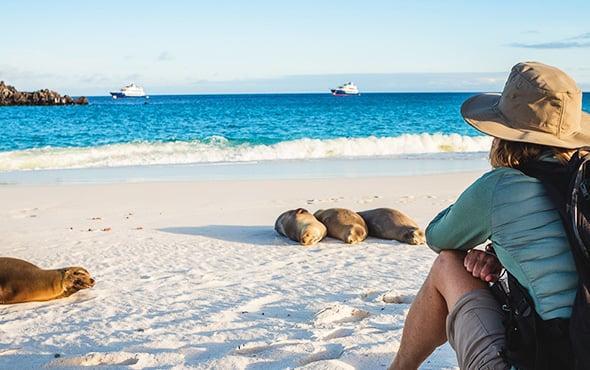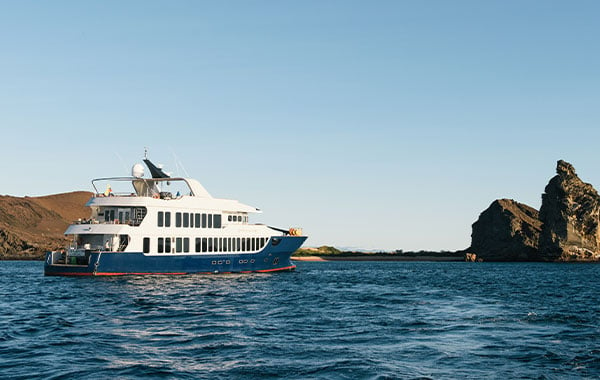7 Islands to Visit in the Galápagos
Born entirely from volcanic eruption, the Galápagos archipelago offers an explosion of stunning, geologically diverse islands that are home to some of the world’s most unique species and landscapes. Of its 13 main islands, these are the top seven to visit.

Santa Cruz (Indefatigable)
Among the Galápagos' three human-inhabited islands, Santa Cruz is home to the largest population, with upwards of 20,000 residents, and the most developed town, lively Puerto Ayora. Beyond its charming shops and pristine beaches (such as Punta Estrada), the lush highlands call to adventurers who discover the awe-inspiring Los Gemelos sinkholes, impressive underground lava tunnels and lumbering giant tortoises in the wild.

Isabela (Albermarle)
The largest of the Galápagos Islands was formed by six shield volcanos, including the active and imposing Volćan Sierra Negra, the second largest caldera in the world. It’s also an especially hot wildlife spot, offering opportunities to see the Galápagos penguin and migratory birds, excellent diving in the Canal Bolívar and Los Tùneles, and a home for both species of Galápagos tortoise.

Genovesa
Expedition ships voyage just above the equator to get to Genovesa, the most northeastern of the Galápagos Islands. But this five-square mile paradise packs a punch, showing off impressive populations of both red-footed and Nazca boobies as well as great frigate birds. Visits to cliff-top Prince Philip’s Steps and Darwin Bay Beach are must-dos.

Española
This top-ranked island for wildlife viewing brims with extremes. Not only is Española the most southerly and less frequented of the Galápagos islands, it offers some of the most dramatic Pacific Ocean views from its rugged cliffs and is home to the rare, endemic hood mockingbird. Those dreaming of a swim on a white-sand beach teeming with sea lions can also do no better than Gardner Bay.

Floreana
A highlight on the oldest of the Galápagos Islands is the chance to visit Post Office Bay, site of a once-functioning mailbox for 18th century whalers, where visitors can now leave their own postcards. Other standouts on Floreana include brilliant snorkeling round Devil’s Crowns, a lagoon boasting dozens of flamingos and a fascinating human history involving the arrival of a toothless German couple in 1928.

Fernandina
Thousands of marine iguanas pile on to the black lava formations at Punta Espinoza. Flightless cormorants nest nearby, while Galapagos penguins toddle in and out of a lagoon framed by mangrove trees. Not just a mecca for wildlife, Fernandina is also an active shield volcano — the youngest of the archipelago’s islands — with stunning displays of ropy pahoehoe and angular aa lava formations.

Bartolomé
This small island just off Santiago is the most photographed in the Galápagos, largely for spectacular views and for its famous Pinnacle Rock, an obelisk-like volcanic cone rising from the ocean’s edge. A trail through a wild lava landscape and up a wooden staircase leads to a windy, 375-foot summit that serves up Bartolomé’s most dramatic views. A small sandy beach below is also a great place to swim with the Galápagos penguin.
Explore More of the Galápagos & Ecuador with A&K

The Galápagos’ Top 10 Animals
Not your typical tropical paradise, the Galápagos is home to extraordinary wildlife not found anywhere else on earth. Put these 12 animals at the top of your must-see list.

The Galápagos: A Living Wildlife Museum
A&K's smaller groups, local connections, long-time local guides and a nimble vessel make a journey to Ecuador's Galápagos Islands unforgettable.







 The Americas
The Americas
 Europe, Middle East and Africa
Europe, Middle East and Africa Australia, NZ and Asia
Australia, NZ and Asia